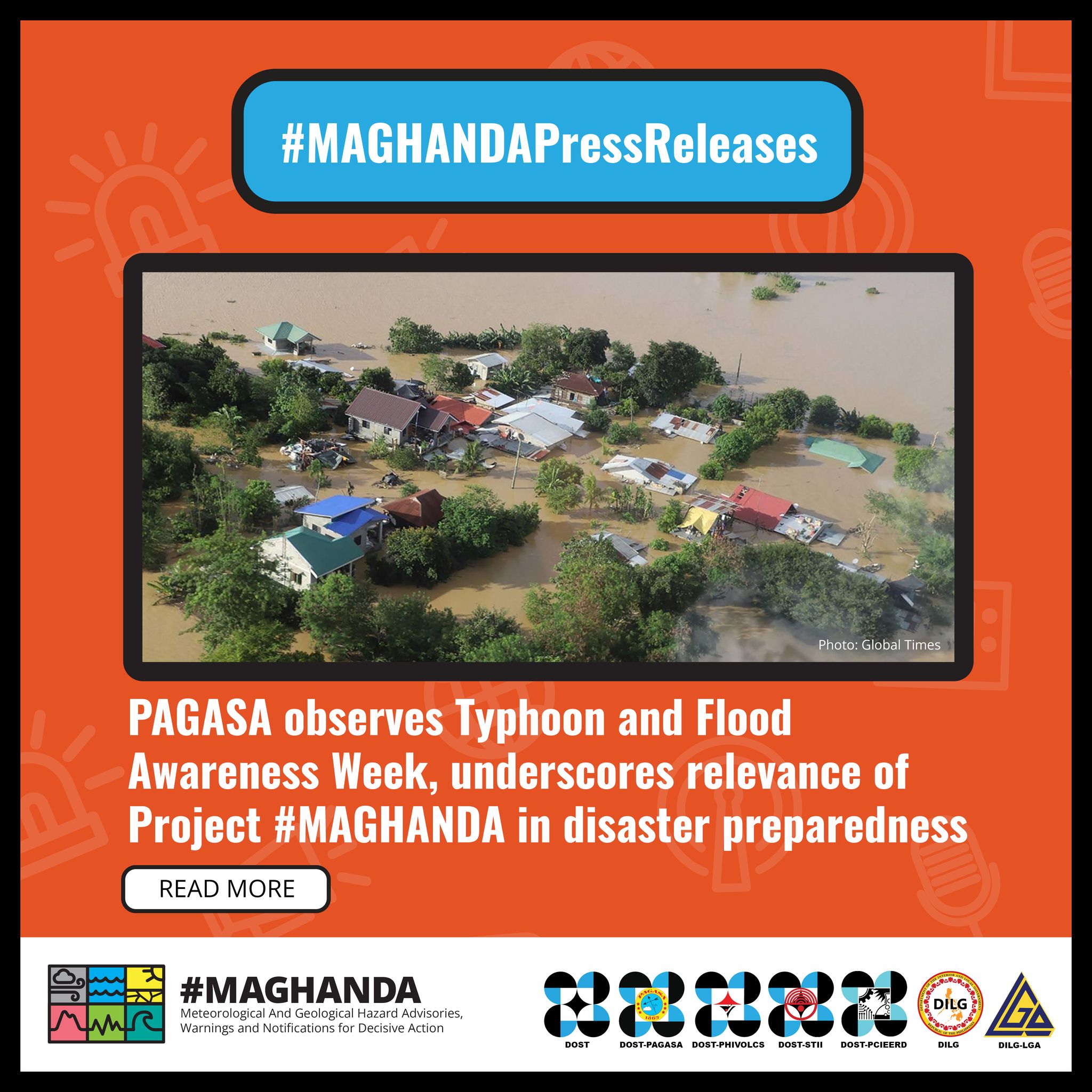PAGASA observes Typhoon and Flood Awareness Week, underscores relevance of Project #MAGHANDA in disaster preparedness

With an average of 20 typhoons that hit the country every year, the DOST-PAGASA vigorously observes the Typhoon and Flood Awareness Week (TFAW) every 3rd week of June to give emphasis on the importance of early warning systems and early action in strengthening disaster action and preparedness to ensure the safety of communities during calamities.
“Mahalaga na prepared tayo at alam natin kung ano yung magiging action kapag inilabas na ng PAGASA yung mga early warning systems (It is important to prepare and know what to do once PAGASA releases the early warning systems),” emphasized Dr. Esperanza O. Cayanan, DOST-PAGASA’s Deputy Administrator for Research and Development. She also reminded the public to help clean the sewage systems to avoid clogging of canals that cause floods during heavy rains and typhoons, underscoring the need for cooperation by all citizens.
This year’s Typhoon and Flood Awareness Week theme, “From Forecast to Action Towards a Typhoon and Flood Resilient Community”, supports DOST-PAGASA’s mandate in providing advanced information against hydrometeorological hazards and utilizing scientific knowledge as tools to ensure the safety, protection, well-being, and resiliency of the people and the whole nation.
This week’s activity will conduct various learning sessions such as webinar on “Maagang Action at Akmang Gawin ayon sa Panahon for Science Teachers and School Disaster Reduction Coordinators in Regions VI, VII, VIII, and NCR on June 21; Information, Education, Communication (IEC) campaign for DRRMOs in Antipolo City, Rizal on June 24; Flood Drill in Sta. Ana, San Mateo, Rizal on June 25; and Media Seminar-Workshop for NCR and MIMAROPA on July 8-10, 2022.
To further help communities better understand the early warning messages on typhoon and flood being released by the frontline agencies, DOST-PAGASA and DOST-PHIVOLCS, Project #MAGHANDA was launched on 16 March 2022 in partnership with DOST-Science and Technology Information Institute (DOST-STII), Department of the Interior and Local Government, and the Local Government Academy to level up awareness and capabilities of the disaster risk reduction managers at the local level in understanding warning messages, and to enable them to translate those information into better response action among its stakeholders particularly those from vulnerable communities.
Project #MAGHANDA stands for Meteorological And Geological Hazard Advisories, Warning and Notifications for Decisive Action and will be implemented in all 17 regions across the country, including the Bangsamoro Autonomous Region in Muslim Mindanao or BARMM.
“With improvements of monitoring tools and services from both agencies and the impact of climate change, there is a need to upgrade the understanding and knowledge of our local government partners and media as well as first responders,” said Dr. Vicente B. Malano, DOST-PAGASA Administrator.
Malano also noted that because there is the possibility that the information was not understood by the people, this initiative will address the need to re-educate the LGUs specifically local officials, disaster managers, and the media on the latest hazard information systems.
To achieve these, the Project #MAGHANDA will conduct trainings and workshops on meteorological and geological hazards via synchronous (Zoom) and asynchronous (LMS-CANVAS) sessions that target governors, mayors, PDRRMO, C/MDRRMO, C/MIO, MLGOO, first responders, and media of the 17 regions of the country. The training and workshop sessions will commence in July and will end on November 2022.
With the line-up of activities, the project will disseminate updated information materials (printed and digital copies) for both hydrometeorological and geological hazards like typhoon and flood, and earthquake and tsunami, to name a few. Another expected output is the updating of the Broadcasters’ Manual that will help media practitioners in understanding the different hazards so they can relate accurate and timely information to the public. Moreover, the Project will produce recommendations and insights that can guide policy-makers in crafting guidelines and policies that are gender-sensitive and inclusive for persons with disability to help better understand early warning messages and to have better response actions toward the goal of safer communities during calamities.
Lastly, Dr. Cayanan, in her closing message encouraged the participation of all individuals in this week’s activities and to remain vigilant and well informed of the warning messages released by the disaster frontline agencies like DOST-PAGASA and DOST-PHIVOLCS to mitigate the negative effects of natural hazards. (30) (By Rowena N. Peter, Project #MAGHANDA, S&T Media Service)

